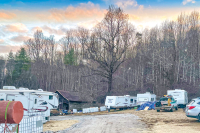Developer loses landmark lawsuit over shoddy roads
By most accounts, calling Art Williams a hands-on developer would be a pretty fair description. For decades, Williams was in the business of subdivision building, first in Florida and then in Western North Carolina.
In pretty much everything, his word was the final say. He picked the land to be developed, he divvied up the plots, he instructed engineers and construction crews. He even sold many of the lots himself.
Even as his health failed, said his wife Anne, her husband was routinely on the scene at the developments. His regular contractors said the same. He was there when the pavement was laid on the roads in Alarka Creek Properties, one of the Williams’ first developments in Swain County. And it was he who approved the words “state-approved paved roads” in brochures advertising the developments. He signed off on the erosion and sediment control plans for the 5.5 miles of roads that crisscross the development.
But it was not Williams who footed the bill when some of those roads began to deteriorate and slide from the mountains they were cut steeply into.
Of the homeowners in the subdivision, many bought their properties directly from Williams and believed the state-approved-roads pitch, until they were left with $40,000 worth of repairs and roads that were, in places, perpetually in peril.
This hadn’t been part of the purchase bargain. And in 2008, the costs and safety concerns reached a critical mass. The Alarka Creek Properties Homeowners Association took the late Williams’ Cane Creek Development Corporation to court, charging that he and his team misled them, saddling them with defective and dangerous roads.
Related Items
Three years later, they won, to the tune of $3 million — the largest judgment court clerks had ever seen in Swain County — and threw into sharp relief the ongoing debate in Western North Carolina over steep-slope development and who is responsible when it falls, literally, to pieces.
What went wrong?
Alarka Creek Properties is a two-pronged development precisely 5 miles from Exit 69, just west of Bryson City. Its twin developments, Timber Creek Estates and Eagles’ Roost, sweep up the faces of neighboring mountainsides, cradling Alarka Creek neatly between them.
They’re not subdivisions in the traditional sense — there’s no pool or clubhouse, and most of the homes aren’t even within shouting distance of one another. They do have gates and a homeowners’ association, but really, the two developments are collections of retirement retreats and second homes, a mixture of already-built houses and empty plots that boast spectacular vistas of the surrounding landscapes.
The roads that lead to and connect them, though, aren’t for the faint of heart or fragile of vehicle. Sitting at the apex of Eagles’ Roost, facing down the mountain isn’t dissimilar to the slow crest of a rollercoaster’s first descent, peering down the long incline. They drop off steeply to one side and hug the sheer mountainside on the other. And though few cars are around to traverse the lanes, meeting one headed in the opposite direction can be a harrowing experience. The views are pastoral — the drive, less so.
The roads are anywhere from seven to 10 feet across. In places, there are signs of distress — fissures and cracking. They’re all passable now, but that hasn’t always been the case.
“We’ve had three multi-thousand dollar slides, we had a road that we had to move 2,000 feet of with blasting,” said John Foster, the homeowners’ association’s one-time president. “Ultimately, the road probably should not have been put in.”
That is, of course, only his opinion.
But, according to a study done by Bunnell-Lammons Engineering, a geotechnical firm out of Asheville, he’s at least partially correct.
There was never a dedicated, detailed road plan drawn up for Alarka Creek’s roads. Swain County doesn’t require one, and unless a developer plans on leaving the road in the state’s care, neither does the state.
There was, however, the required erosion and sediment control plan that detailed how the roads would meet state standards for erosion and run-off on the steep fill slopes — manmade grades with fill dirt pulled from the surrounding mountain.
It’s not a definitive road-building guide, but it spelled out the basic standards for what would be installed at Alarka Creek: road thickness, slope and drainage measures.
And, said the engineering firm, had developers and contractors followed the plans, the roads probably would’ve been fine.
But they didn’t.
Detailing the problems
There are, said the report, four basic reasons for mountain road failure: insufficient pavement thickness, insufficient asphalt compaction, slope instability and bad drainage.
In places, Alarka Creek’s roads showed all four.
Where the plans called for pavement to be two inches thick, in some spots it was only 1.5. They specified six inches of crushed stone under that pavement. Most roads averaged only 5.4. One had barely more than an inch.
Ninety-five to 96 percent compaction is industry standard for a fill slope — unlike the mountain’s native soil, it hasn’t had thousands of years to build up its structural integrity. The more densely packed, the less likely it’ll move around, cracking and sliding. That’s what the plans called for, too.
Most of the subdivision’s roads averaged between 84 and 89 percent compaction.
And then there’s the slope.
The state recommends a two-to-one, horizontal-to-vertical slope ratio at minimum for a safe road. And again, that’s what appeared on the erosion control plan submitted to the North Carolina Department of Natural Resources.
But the engineering firm found some of the slopes to be as steep as one-to-one.
“The roadway fill embankments evaluated have a significant potential for instability because the roadway fill embankments are constructed of loose fill that have a steeper slope inclination than fill soil conditions can support,” read the summary report.
In other words, you can’t have loose dirt and a steep road, too, or eventually, you won’t have a road.
“When you have slopes too steep and base and asphalt too thin, the roads are going to fall apart,” said Dan Bryson of Raleigh, the lead attorney on the homeowners’ side. The case, he said, was simple — poorly constructed roads sold through false advertising.
“When they showed homeowners paved road as an inducement to sell, it was a bait and switch,” said Bryson. “There was significant engineers’ testimony that these roads were not built pursuant to local standards. When you build a road, there’s just some basic things you have to do. And it’s going to take a little bit longer, but you just need to do it right.”
Anne Williams, Art Williams’ widow, disagrees with those assertions. As the sole owner of Cane Creek Development, she is the defendant.
Bryson and his legal team pointed to the multiple slides and alligator cracking — patchwork cracks that resemble the crusty reptilian pattern of an alligator’s back — as signs that the roads were faulty from the outset.
“But that’s typical of all roads in [Western] North Carolina, when you pave them,” said Williams. “All the other evidence was that we had done the right thing, we’d done the best roads we could do. State roads slide all the time, and 90 percent of that road is there the same way we built it.”
Could they have gotten a geotechnical engineer, like BLE, to come and test the sites before the road was laid? Sure, said Williams. But no developer does that, she said; it’s too cost prohibitive.
“You‘re selling lots to average people. This is not a country club setting,” said Williams. “We wanted to build in a way that the average person could buy and have a second home, not what we always called the ritzy ditzy.”
Plus, she said, they knew what they were getting.
“They all personally signed [a statement] that they understood that these were private roads and they were inferior to state roads and that the burden of keeping up the roads would be on the homeowners’ association,” said Williams.
And regardless of the roads’ initial construction, that much is true. Which points to a problem facing not just Swain County, but every mountainside subdivision in the region.
Caveat Emptor
Paul Carlson is a man familiar with degraded land. He’s the executive director of the Franklin-based Land Trust for the Little Tennessee, a non-profit group that works in land preservation. He is concerned about the glut of developments in WNC such as Alarka Creek, where steep lots connected by questionable roads have now fallen to owners to maintain. And those owners may not have always done their homework.
“Perhaps they hadn’t done significant due diligence to find out what they’re getting into, and now collectively own a liability,” said Carlson. And what then? “With poorly designed road systems on these properties, every year that passes the liability is increasing. Well, who’s going to be responsible for that stuff?”
That’s a question that legal precedents like the Alarka Creek case are looking to settle, but historically, a lot of homeowners have been left holding the bag on decaying roads they didn’t think they signed up for.
John Foster certainly didn’t. When he bought his plot in Alarka Creek, he didn’t dream Williams would sell him a lot on an unsafe road. But he didn’t look too far into it, either.
“I thought it was steep, but again with the advertisement of state-approved, I thought, ‘OK, if the state of North Carolina is going to approve this, then I’m OK with it,’” said Foster. “We did sign a release, but what we understood was we were going to maintain the roads, but we were going to be given roads that were maintainable.”
But this, of course, is not actually a given.
The truth is that, when it comes to private roads, no one is really checking.
During pre-trial interviews, lawyers asked that very question: is there anyone who makes sure these roads are being constructed properly? A state agency? Local authorities? A retired volunteer? Anyone?
“When you construct a house, you have an inspector come in and say ‘this house is substantially complete and it has been constructed in conformance with the plans and specs submitted on file’… to your knowledge, there is no one who does that for roads or private roads?” Bryson’s fellow attorney Scott Harris asked Victor Lofquist, a civil engineer in Sylva who did the erosion plan for Alarka Creek and most of Williams’ other projects.
“Not that I am aware of anywhere,” replied Lofquist.
Doug Parker, the excavator who helped install the roads, replied similarly.
“To my knowledge, there is no equivalent to that (a building inspector) on a road development project,” said Parker.
And that’s become pretty clear in the years since mountainside developments began to see their vogue.
Roads have been splintering and slipping off the hills in subdivisions around the region, and local officials began to realize that maybe someone should, in fact, be looking.
Road Regulation
Enter subdivision ordinances, those controversial local laws that give officials a little more power over what’s going up in their jurisdiction and how it’s built.
Haywood County has one that limits cut slopes to 1.5 to one, and spells out things that state erosion control standards do not, such as no organic matter in roadbeds; it will decompose and crack holes in the street. And they keep tabs to make sure it’s all being done according to plan.
“What would happen is if somebody built a subdivision road here that was subject to the erosion control law is you would submit your plan to us, we would give you approval, we would inspect it periodically. Then we do perform a final inspection,” said Marc Pruett, erosion control program director in Haywood County.
In Jackson County, a similar ordinance was passed, drawing some ire from developers in a locale heavy laden with second homes peppering the steep mountain faces.
But when it comes to such laws, there is a schism in the church of steep-slope construction.
Parker told attorneys in his deposition that those regulations helped grind his subdivision road-building work to a halt in Jackson County.
“We used to (build roads) a lot until we had a subdivision ordinance in this county and then it came to a stop,” said Parker. “Pretty much everything in this area that stopped developing because there was restraints of subdivision ordinances.”
Swain County has no such regulations. There was some movement on the idea around 2007. A committee was even formed, spurred by the news that emergency vehicles couldn’t traverse some of the county’s dicier residential roads. Recommendations were made, but nothing ever came of them. Swain commissioners apparently lacked the political will, in a county that doesn’t even have a planning board.
In neighboring Macon County, a so-called steep slope ordinance is in talks. Macon is dealing with the aftermath of the Wildflower development, which is the apocryphal, when-roads-attack story that seems to drift into most steep-slope conversations.
Wildflower was a behemoth of a development on the side of Cowee Mountain that broke ground in 2005, at the height of the mountain real estate upswing. At the time, it was controversial, but only because local residents feared such an influx of inhabitants would overstretch their resources.
Four years later, most of its lots were in foreclosure. Then the ground broke on it: One of its key thoroughfares collapsed, a landslide followed and a subsequent geological survey cast serious doubt on the rest of the roads in the place. Downslope residents were warned to brace for debris in case of extreme weather.
The neighborhood’s manager defended the roads, calling the collapse an isolated incident and pointing to the fact that the rest of the roads had erosion control approval.
But so, presumably, did the decimated road.
Finding solutions
Back on Alarka, the victorious homeowners are not yet rejoicing. Anne Williams maintains that she is an 81-year-old widow who had nothing to do with the roads’ construction and has no money to pay $3 million for their repairs. She said her refusal to settle with the homeowners wasn’t stubbornness, but insolvency.
“The fact is we lost on Alarka. We may have put in $3 million, but none of it came out of the profit. We have not had to pay income tax for profit reasons for at least five years, if not longer than that,” said Williams. She said she’s closed Cane Creek Development, laid off the staff and headed back to Florida to live off her Social Security.
Dan Bryson, however, thinks Williams’ cries of poormouth are, at best, disingenuous. He’s starting another proceeding against her that, in legalese, is called ‘piercing the veil.’ Basically, he’s going after all the other corporations she has, trying to draw some of the sizeable settlement from them.
In the rest of the region, though, the problem of unstable roads persists, though subdivision ordinances and the economy are cutting down on the number of new substandard streets going down.
Gordon Small, who works with the Haywood Waterway Association, is working on a project to help new developers find the most suitable road locations in the first place, rewarding them with a certification if they follow expert suggestions.
“The No.1 source of non-point pollution — or mud in the creek — is roads,” said Small. His group is trying to get county commissioners to get on board with the idea.
“You can’t observe this and not be concerned about that,” he said. “People are beginning to recognize that it’s to their advantage to know what’s going to move and what’s not.”
Carlson, with the Land Trust for the Little Tennessee, said he’s looking toward an inventory of the region’s perilous roads, so at least they can be monitored for movement.
“Clearly in [the last] decade up until 2008, it was absurd to try to make the argument that the highest and best use of steep-slope land was for forestry, but now it’s kind-of interesting to revisit the question,” said Carlson. “I think a lot of these lands — the most marginal, steep, remote lands where these roads were punched in — it may be that no one wants them.”
And for developers still around, the Swain County jury’s decision is ringing clearly through the mountains.
“I think these jurors are tired of developers who come in, deface the mountains and then put in substandard roads, sell out all the lots and then try to avoid liability,” said Dan Bryson. “I hope that this judgment sends a signal to every developer: if you pave a road on a mountain in Western North Carolina, it needs to be done properly.”













